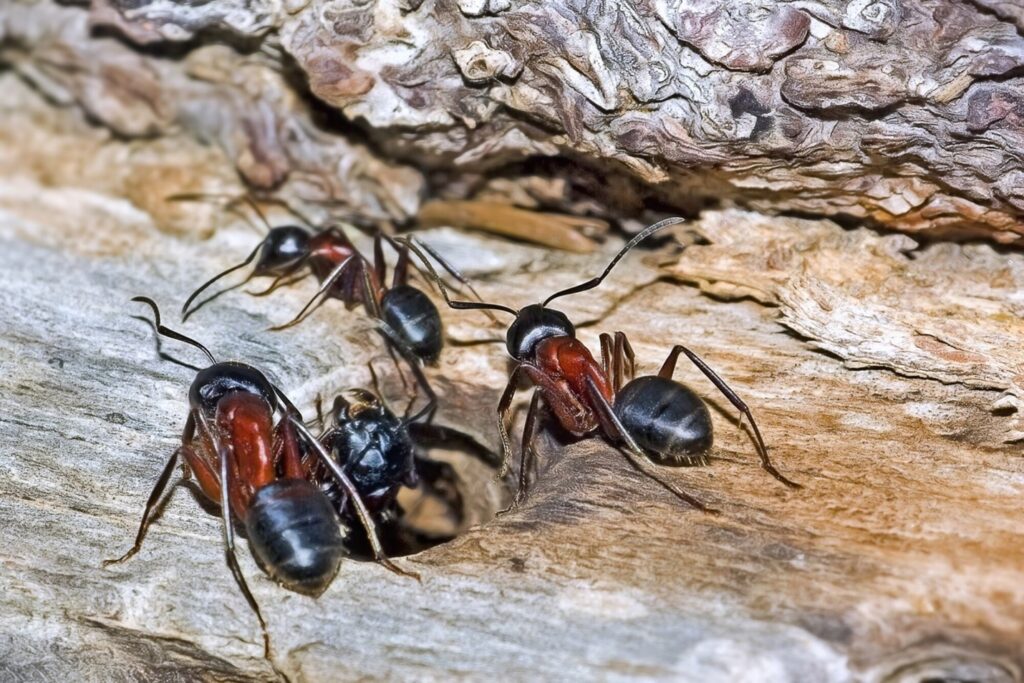Did you know there are about 20 types of fire ants in the United States? Fire ants are well-known as a threat to people playing outdoors, but are they dangerous to your property?
Finding a tree infested with ants can raise some alarms about the tree’s integrity. Will the ants cause the tree to die and fall? Is it safe for a tree to have ant problems?
If you’re interested in pest control to keep your property safe, we’re here to help. Read on to learn about which ant solutions can help you battle different types of ants. We’ll also look into the difference between a DIY fix and hiring professionals.

Signs of Infestation
To start, how do you know if you have an ant infestation? They’re sometimes easy to spot, but some types of ants are more elusive. Here are the three most common signs of ant infestation.
Piles of Wood Pulp
One of the first things you’ll notice is small piles of wood shavings or pulp near your tree. These piles resemble sawdust and are often a darker shade of brown, depending on the tree.
These piles are generally tiny, and on windy days these may not appear due to the sawdust being blown away. If you see these piles, investigate further to see if there are ants or other pests on your tree.
Holes In the Tree
Where is that wood pulp coming from? Ants will dig into the tree, burrowing deeply to make a nest. These tunnels can stretch throughout the tree and will weaken its structure.
Additionally, these tunnels make it more difficult for the tree to transport nutrients and water. As such, this is one of the most important factors in the damage an ant infestation will cause.
Unfortunately, these holes are tiny, only large enough for ants to travel through. Look closely at your tree’s surface and try to find the burrow holes. You may also mistake ants for termites due to this symptom.
Presence of Worker Ants
Finally, the most obvious way to tell if you have an ant infestation is with the presence of worker ants.
Fire ant colonies are made of several types of ants, with worker ants doing the majority of the labor to build and expand a nest. These ants will often leave burrows and explore the tree, making them easier to spot.
If you see worker ants, you don’t always have an infestation. The ants could come from a nearby nest that isn’t infesting the tree as a whole. However, you should always investigate deeper to make sure.
Consequences of Ant Infestation
What’s the problem with finding ants outside?
Ants are pests that can do severe, sometimes fatal damage to a tree. Doing so can cause trees to die out and become unsightly hazards.
Here are three common consequences of an ant infestation.
Damaged Roots
The most common sort of damage ants will cause is to damage the roots of a tree. Building their nests near the root system of a tree can inhibit water and nutrients from entering the roots.
As this happens, the tree will struggle to stay alive. A dying tree is less sturdy and can be blown over onto your home, lawn, or vehicles.
It’s also more common for dying trees to have dead or flimsy branches. These can fall and litter your yard, as well as pose a safety threat.
Ant Swarms
While the damage fire ants can cause is significant, many overlook the threat of the fire ants themselves.
Fire ant venom can cause a severe reaction in people with some allergies. These symptoms include nausea, chest pains, shock, and can even lead to a coma.
If you have young children in your family, it’s critical to handle any ant nests as soon as possible. Fire ants are typically aggressive and can swarm a child’s leg in seconds if they step on the nest.
To learn more about fire ants, we suggest visiting this page on fire ants in Florida. Much of the information applies to other states as well.
Handling a Tree Infested With Ants
How can you handle an infestation once you spot it? Thankfully, ants aren’t as stubborn as some pests like rats or roaches. Here are two ways to handle pest control.
DIY Fixes
Do you prefer to handle problems yourself instead of calling professionals?
DIY fixes for ants are relatively simple. Your first step is to locate the fire ant nest.
Rather than harsh chemicals and pesticides, add roughly 30 drops (or a few tablespoons) of peppermint oil to a gallon of water. Mix it thoroughly and add it to a sprayer.
Spray the peppermint oil around the base of the tree. Ants are sensitive to peppermint oil and are repelled by this mixture. Do this several times over the course of 3-6 days.
Once the tree is covered in oil, go to the nest and spray it with a strong insecticide. Make sure you cover their trails as well, as this will stop them from going to a new nest. Repeat this process as necessary.
Hiring a Professional
DIY fixes are nice, but they’re rarely cheaper once you’ve purchased the equipment. You also will need to dedicate the time and effort to doing the job yourself.
Instead, you may prefer to call a professional pest control company. These companies have experts that can handle the ant nests for you.
They also are trained to ensure they don’t damage your property. You won’t have to worry about them using insecticides that will damage your tree worse than the ants already are.
Check your local social media pages for reliable and affordable pest control experts. Your neighbors may have suggestions as well.
Helping Your Yard
Handling a tree infested with ants feels intimidating, but it’s a relatively easy task. As a DIY project, you’ll need to make sure you thoroughly eradicate the ants. If you’re hiring professionals, research deeply to ensure you’re getting trustworthy and skilled contractors.
For more informative reads, be sure to browse the rest of our site.







Leave a Comment
You must be logged in to post a comment.